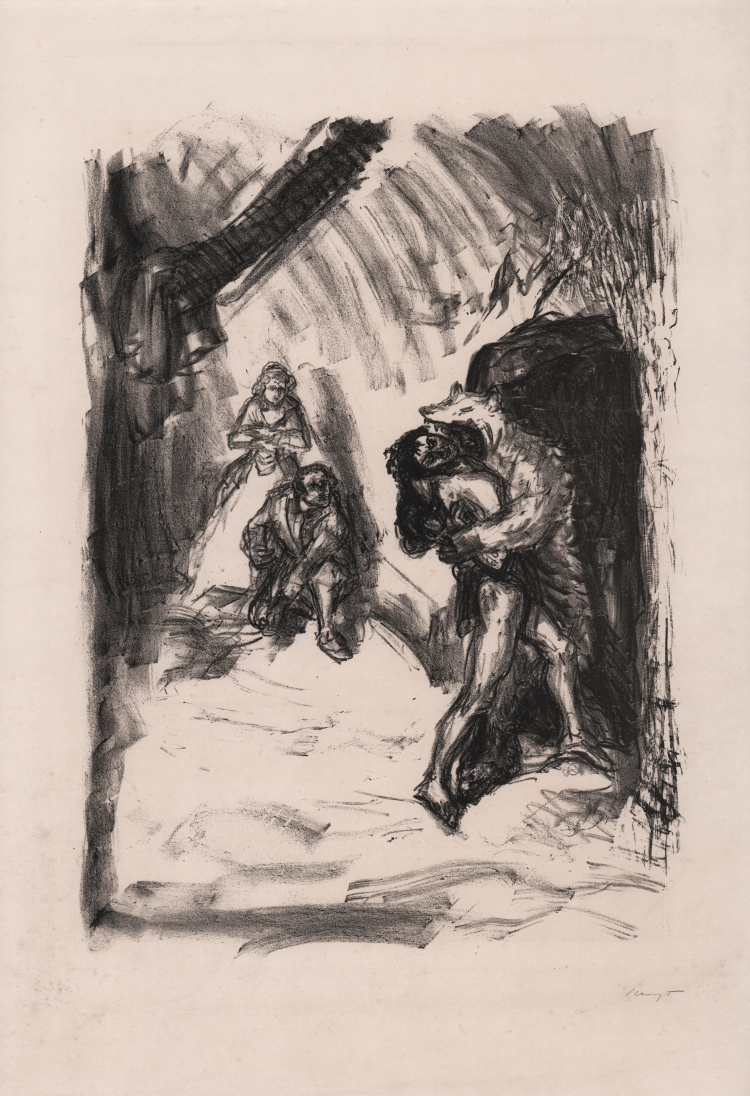



| Reference: | S42270 |
| Author | Max SLEVOGT |
| Year: | 1908 ca. |
| Measures: | 330 x 370 mm |


| Reference: | S42270 |
| Author | Max SLEVOGT |
| Year: | 1908 ca. |
| Measures: | 330 x 370 mm |
Lithograph, 1908, signed in pencil 'Slevogt'
Falkenauge, als Bär vermummt, überwältigt Magua. Im Hintergrunde Duncan und Alice (Hawk Eye, disguised as a Bear, overwhelms Magua. Duncan and Alice in the background), page 159 from the book Lederstrumpf-Erzählungen (The Leatherstocking Tales) by James Fenimore Cooper (Berlin: Pan-Presse, 1909).
In 1908 Paul Cassires established the Pan-Presse to publish fine illustrated books and original graphic art; the first effort of the press was the Leatherstocking Tales, illustrated by Max Slevogt.
Perfect conditions.
Max SLEVOGT (Landshut 1868 - Neukastel, Landau, 1932)
|
In Munich, the young Slevogt studied at the Academy, before settling there as a freelance artist and exhibited publicly from 1892. With works such as "After the Bath," a prime example of his crude-realistic painting, which was vilified as "gutter art," Slevogt earned the epithet "The Terrible." So he could not succeed in Munich. At the insistence of the Berlin Secession, especially Max Liebermann, Slevogt left Munich and moved to the Prussian capital, where his works were already very much appreciated in the 1890 years. On the way to Berlin Slevogt spent several weeks in Frankfurt, where he held connections to the Städel Art Institute. At that time, he created his famous series »Frankfurt Zoo Pictures«, which highlighted the brightening of the color palette as well as the turn towards the depiction of leisure pleasures. It represents the breakthrough of Slevogt's open-air painting, which later also appears in the cycle of the "pictures of Egypt" and countless palatinate landscapes. With 150 works in the fields of printmaking and painting, the Landesmuseum Hannover draws a comprehensive picture of the artist Max Slevogt. The equality of graphics and painting is one of the central aspects of Slevog's own concept of art: "When I try to give greater meaning to the word illustration, I draw all the representations, painted or drawn, into this unity: art." With these words In his essay "Pro Domo," the artist has already contradicted 1924's view that book illustration does not belong to art. This is followed for the first time by a retrospective, which places the print-graphic work equally alongside the artist's painting.
|
Max SLEVOGT (Landshut 1868 - Neukastel, Landau, 1932)
|
In Munich, the young Slevogt studied at the Academy, before settling there as a freelance artist and exhibited publicly from 1892. With works such as "After the Bath," a prime example of his crude-realistic painting, which was vilified as "gutter art," Slevogt earned the epithet "The Terrible." So he could not succeed in Munich. At the insistence of the Berlin Secession, especially Max Liebermann, Slevogt left Munich and moved to the Prussian capital, where his works were already very much appreciated in the 1890 years. On the way to Berlin Slevogt spent several weeks in Frankfurt, where he held connections to the Städel Art Institute. At that time, he created his famous series »Frankfurt Zoo Pictures«, which highlighted the brightening of the color palette as well as the turn towards the depiction of leisure pleasures. It represents the breakthrough of Slevogt's open-air painting, which later also appears in the cycle of the "pictures of Egypt" and countless palatinate landscapes. With 150 works in the fields of printmaking and painting, the Landesmuseum Hannover draws a comprehensive picture of the artist Max Slevogt. The equality of graphics and painting is one of the central aspects of Slevog's own concept of art: "When I try to give greater meaning to the word illustration, I draw all the representations, painted or drawn, into this unity: art." With these words In his essay "Pro Domo," the artist has already contradicted 1924's view that book illustration does not belong to art. This is followed for the first time by a retrospective, which places the print-graphic work equally alongside the artist's painting.
|